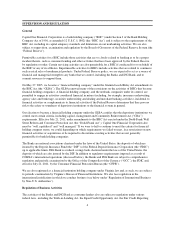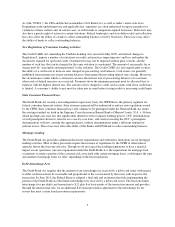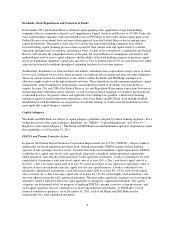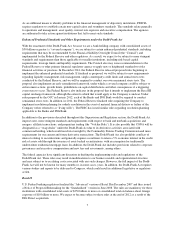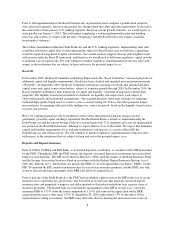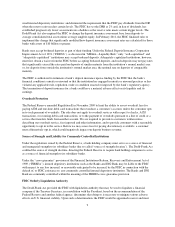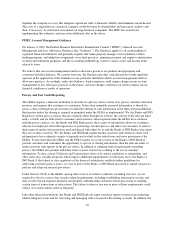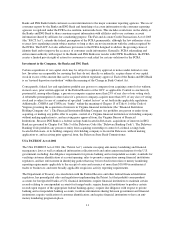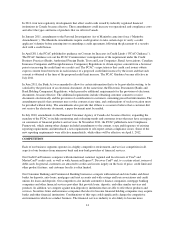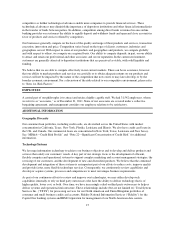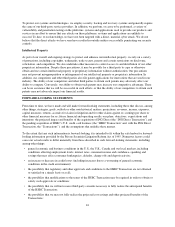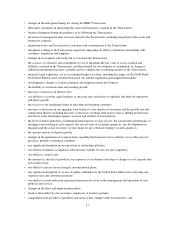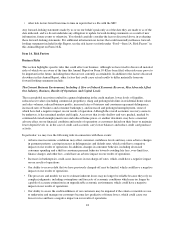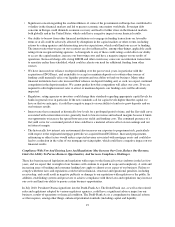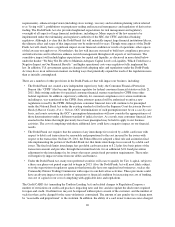Capital One 2011 Annual Report Download - page 34
Download and view the complete annual report
Please find page 34 of the 2011 Capital One annual report below. You can navigate through the pages in the report by either clicking on the pages listed below, or by using the keyword search tool below to find specific information within the annual report.
In 2011, four new regulatory developments that affect credit cards issued by federally regulated financial
institutions in Canada became effective. These amendments could increase our operational and compliance costs
and affect the types and terms of products that we offer in Canada.
In January 2011, amendments to the Personal Investigations Act of Manitoba came into force (“Manitoba
Amendments”). The Manitoba Amendments require credit grantors to take certain steps to verify a credit
applicant’s identity before entering into or amending a credit agreement, following the placement of a security
alert with a credit bureau.
In April 2011, the FCAC published its guidance on Consent for Increases in Credit Limits (“FCAC Guidance”).
The FCAC Guidance sets out the FCAC Commissioner’s interpretation of the requirement under the Credit
Business Practices (Banks, Authorized Foreign Banks, Trust and Loan Companies, Retail Associations, Canadian
Insurance Companies and Foreign Insurance Companies) Regulations to obtain express consent from a borrower
prior to increasing the credit limit on a credit card. The FCAC’s expectation is that credit card issuers obtain
express consent from borrowers in each instance of a proposed credit limit increase by the issuer and that such
consent is obtained at the time of the proposed credit limit increase. The FCAC Guidance became effective in
July 2011.
In June 2011, the Bank Act was amended to allow for certain information that is to be provided in writing, to be
satisfied by the provision of an electronic document. At the same time, the Electronic Documents (Banks and
Bank Holding Companies) Regulations, which prescribe additional requirements for the provision of electronic
documents, became effective. The additional requirements include obtaining customer consent to receive
documents electronically and the provision of a notification to customers containing prescribed information. The
amendments specify that customers may revoke consent at any time, and confirmations of such revocation must
be provided without delay. The amendments also provide that if there is a reason to believe that a customer did
not receive the electronic document, a paper document must be mailed.
In July 2010, amendments to the Financial Consumer Agency of Canada Act became effective, expanding the
mandate of the FCAC to include monitoring and evaluating trends and consumer issues that may have an impact
on consumers of financial products and services. In November 2011, the FCAC published a new Compliance
Framework, which among other changes included amendments to the content, scope and frequency of existing
reporting requirements and introduced a new requirement to self-report certain compliance issues. Some of the
new reporting requirements were effective immediately, while others will be effective on April 1, 2012.
COMPETITION
Each of our business segments operates in a highly competitive environment, and we face competition in all
aspects of our business from numerous bank and non-bank providers of financial services.
Our Credit Card business competes with international, national, regional and local issuers of Visa®and
MasterCard®credit cards, as well as with American Express®, Discover Card®and, to a certain extent, issuers of
debit cards. In general, customers are attracted to credit card issuers largely on the basis of price, credit limit and
other product features, and customer loyalty is often limited.
Our Consumer Banking and Commercial Banking businesses compete with national and state banks and direct
banks for deposits, auto loans, mortgages and trust accounts and with savings and loan associations and credit
unions for loans and deposits. Our competitors also include automotive finance companies, mortgage banking
companies and other financial services providers that provide loans, deposits, and other similar services and
products. In addition, we compete against non-depository institutions that are able to offer these products and
services. Securities firms and insurance companies that elect to become financial holding companies may acquire
banks and other financial institutions. Combinations of this type could significantly change the competitive
environment in which we conduct business. The financial services industry is also likely to become more
14


